
- Tom Brady is the undisputed featured quarterback: Brady is not just the highest-graded quarterback of the PFF era, but also the highest-graded player overall as the clear choice for QB1 on this list.
- Aaron Donald leads a defense full of stars as the highest-graded defender in PFF history: Donald’s dominance in his 10-year career may never be replicated, considering some of the PFF records he set during his time in the league.
- Subscribe to PFF+: Get access to player grades, PFF Premium Stats, fantasy football rankings, all of the PFF fantasy draft research tools and more!
Estimated Reading Time: 15 minutes

We’re a quarter of the way into the 2000s, which has accounted for several lifetimes in the NFL world, giving us many superstars, Hall of Famers and future Hall of Famers. Now, we’re creating the best team possible of players from the past 25 years.
PFF’s grading of every player on every play in every game started in 2006, so this isn’t a true quarter-century list, but there will be exceptions for those who are deserving but played from 2000-2005. PFF’s best-in-class database powers the numbers behind these career grades, which help contextualize the best players of the 2000s.
QUARTERBACK: Tom Brady (98.6 Career PFF Grade)
It’s no surprise that the greatest quarterback of all time earned the highest career overall grade across all positions in PFF history.
Brady accounts for half of the six highest season-long PFF passing grades in the PFF era, between his 2017 (93.4), 2007 (93.9) and 2016 (94.2) campaigns. No statistic quite holds up to seven Super Bowl victories, but Brady’s 2.0% turnover-worthy play rate on more than 12,000 PFF-graded dropbacks is a remarkable feat.
Honorable Mention: Peyton Manning
Tom Brady’s Final 10 NFL Seasons
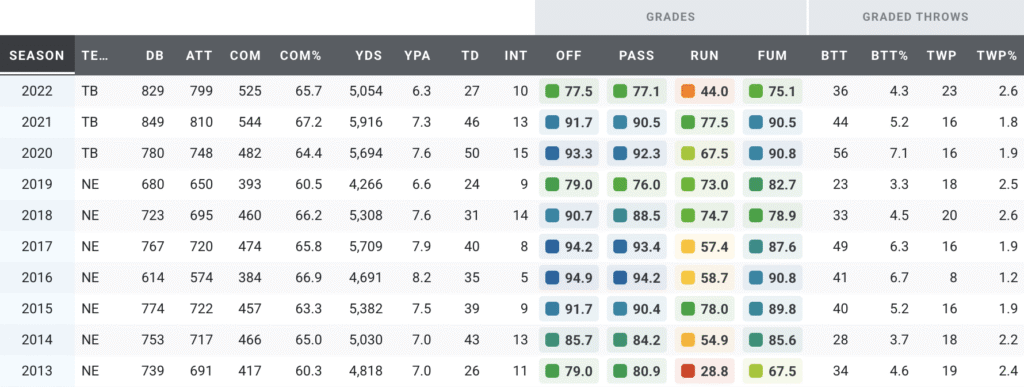
RUNNING BACK: Derrick Henry (96.8 Career PFF Grade)
Henry’s inclusion as the highest-graded running back in PFF history is made all the more impressive by the fact that he is still going at 30 years old and just engineered the best-graded season of his career in Year 9.
In his first year with the Baltimore Ravens in 2024, Henry led the league in both PFF overall grade (94.1) and PFF rushing grade (93.5) for his position while posting a career-high 6.0 yards per carry on 367 attempts. His 3.6 yards after contact per attempt in his career is the second-best mark of all time among 159 qualifying running backs — behind only Nick Chubb (3.8), though Henry has handled nearly double the number of carries.
Honorable Mention: Marshawn Lynch
WIDE RECEIVER: Antonio Brown (94.9 Career PFF Grade)
Brown is the highest-graded wide receiver in the PFF era, doing so as the ultimate target earner across his 12 NFL seasons, with the highest career target rate (27.1%) among 181 qualifying wide receivers since 2006.
In 2015, Brown was the first player in the PFF era to see more than 200 targets in a season (playoffs included). He delivered 1,953 yards and the highest PFF receiving grade in a season (92.6) at the time. Brown ranks in the top five at his position since 2006 in career yards per route run (2.45), yards after the catch (4,903) and overall receiving yards (13,209).
WIDE RECEIVER: Julio Jones (94.8 Career PFF Grade)
Jones enjoyed five straight seasons (2015-19) with at least a 90.0 PFF receiving grade, a feat that hasn’t been replicated. No other wide receiver has more than three such seasons in their NFL careers.
Jones’ dominance over that stretch is one of the more impressive accomplishments in PFF history, with his 2016 season standing out, in particular. He set a record for PFF receiving grade in a season (93.4) at that point, beating Antonio Brown’s 2015 mark. Jones’ 2.53 yards per route run for his career is still the top mark for a wide receiver who has played more than six NFL seasons since 2006, and his 409 career explosive receptions (15-plus yards) are still the most in PFF history.
WIDE RECEIVER: Tyreek Hill (93.8 Career PFF Grade)
Hill is entering Year 10 of his NFL career and boasts a significant sample size of dominance, featuring the third-best PFF receiving grade for his position and several single-season records.
Hill broke Julio Jones’ PFF record for receiving grade in a season by delivering a 93.8 mark, and he also set a record in yards per route run in a season (3.72) — a title previously held by Steve Smith for 15 years (2008).
Honorable Mention: Calvin Johnson
TIGHT END: Rob Gronkowski (94.0 Career PFF Grade)
While Julio Jones holds the record for most seasons with at least a 90.0 PFF receiving grade (five), Gronkowski holds the record across all positions with six such campaigns, between 2011 and 2017.
Gronkowski’s 14.8 yards per reception over his career is the best mark in the PFF era among qualifying tight ends. He also boasts the most receiving touchdowns in the PFF era (107), having delivered 20 in 2011 alone, 17 of which came in the regular season — also the most all time.
Honorable Mention: George Kittle
LEFT TACKLE: Joe Thomas (96.8 Career PFF Grade)
Thomas is truly one of the best of all time at his position, having delivered the highest career PFF pass-blocking grade of any offensive lineman in the PFF era (95.9).
Thomas allowed just a 4.0% pressure rate in his career, the second-best mark among all offensive tackles with at least 5,000 pass-blocking snaps. He holds the PFF record for most seasons (six) with a pass-blocking grade above 90.0. For context, honorable mention Trent Williams, who has six seasons of 90.0-plus PFF overall grades, has just one season with a 90.0-plus PFF pass-blocking grade.
Honorable Mention: Trent Williams
LEFT GUARD: Logan Mankins (93.2 Career PFF Grade)
Mankins is the highest-graded left guard to play more than 7,000 offensive snaps in the PFF era, specifically on the back of his run blocking. No left guard has delivered a higher PFF run-blocking grade for their career than Mankins since 2006 (93.1).
The long-time New England Patriot was most dominant between 2007 and 2010, when he posted four straight seasons with at least a 90.0 PFF run-blocking grade. He was the highest-graded run blocker among all offensive linemen over that span (95.4), and the second-highest-graded offensive lineman overall (95.4).
Honorable Mention: Evan Mathis
CENTER: Nick Mangold (95.3 Career PFF Grade)
Mangold burst onto the scene in 2006 as a rookie, posting a 94.0 PFF pass-blocking grade, which still stands as the best mark for a center.
From that point on, Mangold established himself as the best center in the PFF era, posting the second-highest career PFF pass-blocking grade for the position (93.0) and ranking in the top five at the position in career pass-blocking efficiency (99.1), career pressure rate allowed (1.9%) and career knockdown rate allowed (0.5%) among 55 qualifiers since 2006.
Honorable Mention: Jason Kelce
Nick Mangold’s Career PFF Grades
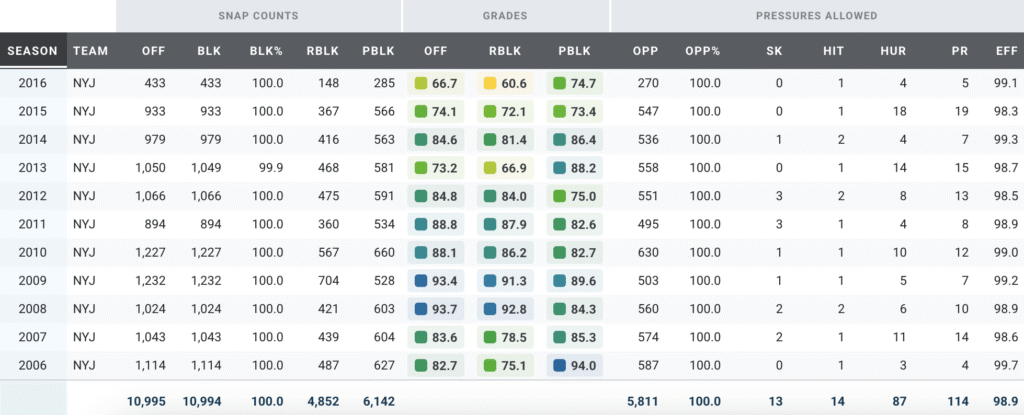
RIGHT GUARD: Marshal Yanda (93.6 Career PFF Grade)
Across 13 NFL seasons — all with the Baltimore Ravens — Yanda never posted a PFF blocking grade or PFF overall grade below 72.2 in a season, standing out as a poster child of high-end consistency.
Yanda’s best pass-blocking campaign came in 2016, when he allowed the lowest pressure rate in a season (1.0%) for his position (minimum 450 pass-blocking snaps) and didn’t let up a single sack or quarterback hit. He stands as the only offensive guard to rank in the top five in career PFF overall grade (93.6), career PFF run-blocking grade (91.7) and career PFF pass-blocking grade (91.3) among 274 qualifying players since 2006.
Honorable Mention: Zack Martin
RIGHT TACKLE: Lane Johnson (92.8 Career PFF Grade)
Johnson is coming off his 12th NFL season, which resulted in his second Super Bowl victory and the best PFF overall grade (88.9) of his career. It was the cherry on top of a dominant career in which he owns the best knockdown rate allowed (sacks plus quarterback hits) among offensive tackles with at least 4,500 pass-blocking snaps (1.1%).
Johnson’s 2024 season proved that he’s aging like a fine wine, as one of just three players (Andrew Whitworth and Tristan Wirfs) to post two of the 15 lowest pressure rates allowed in a season for the position since 2006 — one in 2022 (1.8%) and the other in 2024 (2.6%).
Honorable Mention: Mitchell Schwartz
INTERIOR DEFENDER: Aaron Donald (97.2 Career PFF Grade)
Donald is the highest-graded defensive player of the PFF era and one of the most dominant players the league has ever seen. He holds eight PFF records for his position, specifically as a pass rusher, thanks to owning all six of the best pass-rush grade seasons ever for his position.
Donald delivered nine straight seasons with at least a 90.0 PFF pass-rush grade, a feat that may never be repeated. He is one of just three interior defensive linemen to post more than 100 quarterback pressures in a season, and he did it four times in his NFL career.
INTERIOR DEFENDER: J.J. Watt (93.9 Career PFF Grade)
Watt split his time between edge defender and interior defensive lineman, the latter of which is where he features on this list, as his most dominant seasons at that position are the only ones to come close to rivaling Aaron Donald.
The second-highest-graded interior defensive linemen in the PFF era delivered a record 119 quarterback pressures for the position and a 92.9 PFF pass-rush grade in 2014, which ranks just outside Donald’s six best seasons of all time. Watt also put together three of the five seasons with the most sacks for the position, leading to the third-most sacks (120.5) in the PFF era, including the playoffs.
Honorable Mention: Chris Jones
EDGE DEFENDER: Von Miller (95.1 Career PFF Grade)
The honor of the most career sacks (139) in the PFF era also happens to belong to the highest-graded edge defender of all time. Miller’s career spans 13 seasons, exactly 10,000 defensive snaps, and is still going.
He owns nine seasons with at least a 90.0 PFF overall grade — by far the most at the position, as the next closest player (Khalil Mack) has six. Miller joins Nick Bosa as the only edge defender to rank in the top five in career pressure rate (16.5%), career pass-rush win rate (16.7%) and career PFF pass-rush grade (93.9).
EDGE DEFENDER: Myles Garrett (94.8 Career PFF Grade)
Garrett is arguably the most effective pass rusher in the PFF era, earning the highest career mark for the position (95.5) through his eight NFL seasons. He has now posted six straight seasons with at least a 90.0 PFF pass-rush grade, ranking first at his position three times and no worse than in the top 10 in every season outside of his rookie year.
Garrett’s career 20.9% pass-rush win-rate is the top mark among edge defenders — and 2.4 percentage points higher than the next closest qualifying player (Nick Bosa).
Honorable Mention: Khalil Mack
Myles Garrett’s Career PFF Grades
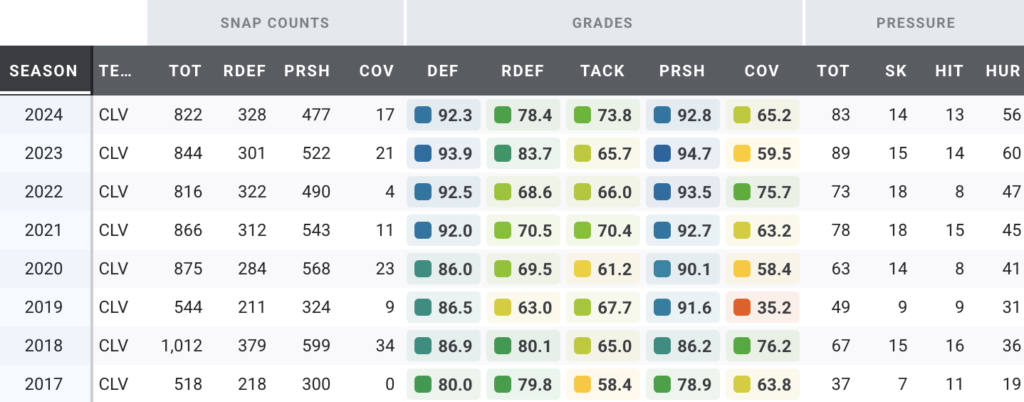
LINEBACKER: Patrick Willis (94.3 Career PFF Grade)
Willis finished his NFL career with the highest PFF overall grade ever for the position and is the only linebacker to rank in the top five in career PFF overall grade, career PFF run-defense grade (94.5), career PFF coverage grade (94.1) and career missed tackle rate (5%).
He was never worse than a top-three-graded linebacker overall for six straight seasons, from 2008 to 2013, and was No. 1 in that regard twice.
LINEBACKER: Ray Lewis (91.8 Career PFF Grade)
Lewis’ career dates back further than PFF grading, beginning in 1996, though he is deserving of making the quarter-century team when projecting the start of his career — five first-team All-Pro appearances and two Defensive Player of the Year awards — to the PFF era.
Once PFF’s grading began, Lewis produced one of the best career grades for the position, ranking among the top five linebackers since 2006. His 2009 season was his best captured by PFF, as he delivered a 91.4 PFF overall grade — the top mark that year and tied for the third-best season all time for the position.
Honorable Mention: Bobby Wagner, Luke Kuechly
CORNERBACK: Richard Sherman (94.8 Career PFF Grade)
Sherman is the highest-graded cornerback of the PFF era, both overall and in coverage (95.2). He was the league’s top-graded cornerback three times (2012, 2013 and 2019) in his illustrious career.
Typical coverage stats don’t always do Sherman’s performance justice, as offenses did their best to avoid him in the passing game. When he ranked in the top 10 in coverage snaps in a season, he ranked in the top 25 in coverage targets only once (2012). And he never placed in the top 50 in targets when playing a top-10 snap count. His career yards allowed per coverage snap figure (0.78) ranks as the second-best mark in the PFF era among 137 qualifying cornerbacks.
CORNERBACK: Antoine Winfield (94.5 Career PFF Grade)
Winfield’s NFL career began in 1999, though even his seven remaining seasons in the PFF era yielded one of the best career marks of all time. He was among the 10 highest-graded players for his position in five out of seven years, and the top-graded player at his position three times between 2006 and when he retired in 2012.
While Winfield owns a top-10 PFF coverage grade all time (92.3), where he’s unique on this list of cornerbacks is that he also owns the best PFF run-defense grade (94.7) out of 355 qualifiers at the position since 2006. Winfield’s 107 run defense stops are tied for the second most of all time among cornerbacks, while his 2.47-yard average depth of tackle against the run ranks as the best mark among 137 qualifiers since 2006.
CORNERBACK: Darrelle Revis (94.4 Career PFF Grade)
Revis Island peaked between 2008 and 2014, during which he was one of the 10 highest-graded cornerbacks in every single season and the top-graded cornerback in PFF coverage grade twice.
Revis’ best season came in 2009, when he posted a 93.4 PFF coverage grade — still the best mark of the PFF era for the position, as are his 24 pass breakups that season. Revis ranks behind only Richard Sherman (50.1%) in career completion rate allowed since 2006 (50.6%).
Honorable Mention: Champ Bailey
Darrelle Revis’ Career PFF Grades
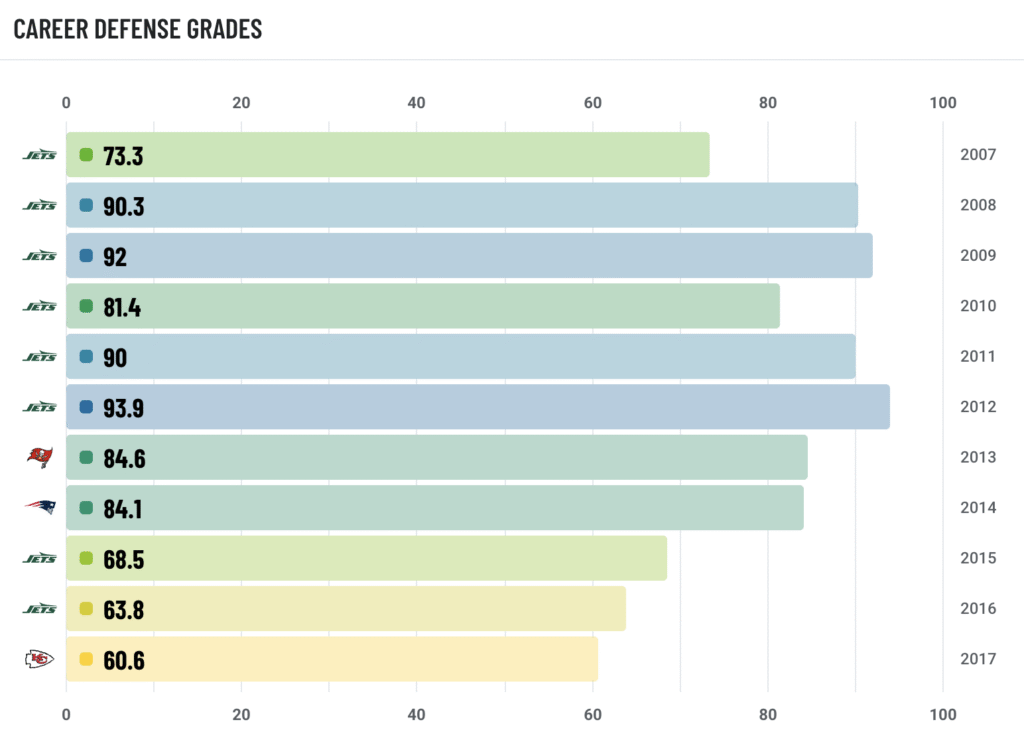
SAFETY: Troy Polamalu (93.0 Career PFF Grade)
Both safeties on this list began their careers before PFF grading in 2006, so some projection is involved here. Polamalu made the Pro Bowl twice and was either a first- or second-team All-Pro in 2004 and 2005.
Even without those seasons recorded by PFF, Polamalu earned the top career PFF coverage grade (94.0) and a top-five career PFF overall grade among 127 qualifying safeties. Most impressive is that he owns the best first-down-plus-touchdown rate (28.9%) among the same qualifying safeties when targeted and the best receiving yards allowed per coverage target figure (5.6).
SAFETY: Ed Reed (92.3 Career PFF Grade)
Much like Polamalu, Reed began his career before PFF grading commenced. We missed out on his 2004 Defensive Player of the Year season and two All-Pro and Pro-Bowl performances.
In the years that followed, Reed delivered the second-highest career forced incompletion rate (19.3%) of the PFF era among 116 qualifying safeties. His 93.4 PFF coverage grade in 2009 was the third-best mark ever captured for the safety position by PFF, while his 91.8 PFF overall grade that year is tied for the fourth-best single-season mark.
Honorable Mention: Eric Weddle
KICKER: Matt Prater (95.1 Career Kicking Grade)
Prater has logged more than 700 combined field goals and extra point attempts in his NFL career with a 97% accuracy rate on extra points and an 86% accuracy rate on field goals, leading to a top-two field goal/extra point grade (95.1).
Prater is one of just three kickers in the PFF era with at least 80 field goal attempts of less than 30 yards who never missed a kick from that range. He is the only kicker to fit in that cohort and have at least 90% accuracy from 30-39 yards and at least 75% accuracy from 40-49 yards and 50-plus yards.
PUNTER: Pat McAfee (95.3 Career Punt Grade)
McAfee is the highest-graded punter of the PFF era by a significant margin, with the next closest player being AJ Cole (89.3). That six-point gap is the largest of any position on this list.
McAfee’s 4.54-second average hangtime on 611 qualifying punts is a top-five mark all time among qualifying punters, and he added 214 punts that landed inside the opponent’s 20-yard line. His 46.4 average punt yards per attempt was also a top-15 mark in the PFF era.
This news was originally published on this post .






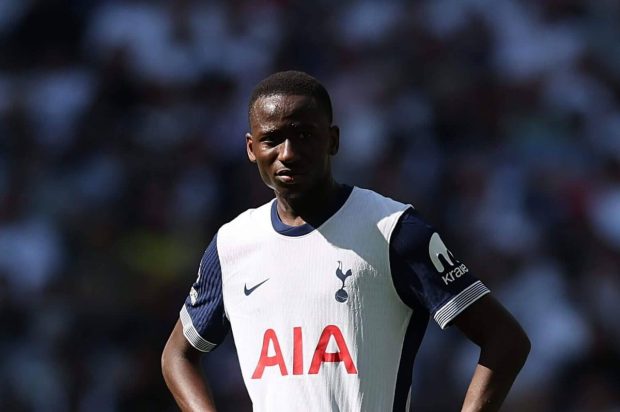
Be the first to leave a comment